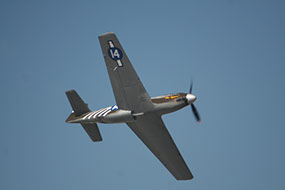p-51A Mustang
 North American Aviation P-51A serial number 43-6251 was built at their facility at Inglewood, California in April 1943 and was received by the United States Army Air Force on April 26 1943. 43-6251 was initially flown across the country arriving at Orlando Army Air Field arriving on April 30 1943, the home of Fighter Command School as part of Tactical Air Command. On May 5 1943 saw 43-6251 transferred to Zephyr Hills Army Air Base. Later on July 19 1943 this aircraft was briefly stationed at Leesburg Army Air Base before returning to Zephyr Hills on August 1 1943. After these brief stints at Leesburg and Zephyr Hills, 43-6251 returned to Orlando Army Air Base.
North American Aviation P-51A serial number 43-6251 was built at their facility at Inglewood, California in April 1943 and was received by the United States Army Air Force on April 26 1943. 43-6251 was initially flown across the country arriving at Orlando Army Air Field arriving on April 30 1943, the home of Fighter Command School as part of Tactical Air Command. On May 5 1943 saw 43-6251 transferred to Zephyr Hills Army Air Base. Later on July 19 1943 this aircraft was briefly stationed at Leesburg Army Air Base before returning to Zephyr Hills on August 1 1943. After these brief stints at Leesburg and Zephyr Hills, 43-6251 returned to Orlando Army Air Base.
AAFSATS’s mission
Orlando Army Air Base was the home of the Army Air Forces’ Tactical Air Command. Orlando Army Air Bases’ function during this period was as the primary base for the Army Air Forces School of Applied Tactics. AAFSATS’s mission was to train newly formed units in combat operations under simulated field conditions and these units would later be formed into combat groups. The training at Orlando and its satellite bases were also involved in tactical doctrine development. Here they tested new tactics and disseminated their conclusions and procedures to combat units around the world.
43-6251 was transferred
Later that year 43-6251 was transferred briefly to Kissimmee Army Air Field, another of Orlando Army Air Base’s satellite fields before being transferred to the Training Command and was based at Matagorda Peninsula Army Air Base at Matagorda Island, Texas . At Matagorda Army Air Base, pilots received advanced single engine aircraft training as part of the 62nd Single Engine Flying Training Group. They also received training in aerial gunnery at this location. After Matagorda 43-6251 was again transferred this time to Foster Army Air Base where its duties continued with Training Command.
Training command completed
On May 14 1945, with its duties with Training Command completed and the war in Europe at an end and the war in the Pacific coming to an eventual conclusion, 43-6251 was flown to Albuquerque, New Mexico and transferred to the Reconstruction Finance Corps. The conclusion was reached that worn out and obsolete aircraft like 43-6251 had no future in the post war air force that had an eye looking forward to jet powered aircraft. At Albuquerque, 43-6251 was given inventory number 1181, demilitarized and placed into storage where surplus aircraft could be sold, donated to schools or VFW facilities or to cities for memorials, or more likely, scrapped on site.
To receive surplus aircraft
Eventually 43-6251 was acquired by Cal Aero Technical Institute in Glendale, California. To receive surplus aircraft, Cal Aero was to pay a disposal fee and transportation costs and finally to sign paperwork stating that the aircraft would be made non-airworthy and was for instructional use only. 43-6251 was fortunate in that it was one of the very few and possibly the only aircraft that left Albuquerque intact, the vast majority of the 1551 aircraft at this airfield were scrapped on site.
Ground instructional airframe
After two years of constant service as a stateside training aircraft and eight years as a ground instructional airframe, 43-6251 finally saw the beginning of its real future. In 1953 43-6251 was acquired by Ed Maloney and was stored for the next four years until in January 1957, Mr. Maloney opened the doors of The Air Museum on route 66 in Claremont, California where it was put on static display. Later after a move to new facilities at the Ontario International Airport, Ontario, California, 43-6251’s fortunes changed for the better. In 1967 the P-51A was taken in hand for a restoration to airworthy condition. This project was initially under the direction of Northrop Engineer Jerold Lentz. After several starts and stops on the project and a move to a permanent location at the Chino Airport in Chino, California, on August 19 1981, 43-6251 finally took to the skies again. One month later, 43-6251 was flown to Stead Field in Reno, Nevada to participate in the 17th Annual National Championship Air Races. During this event, 43-6251 was raced by both Jim Maloney, Ed Maloney’s son and Steve Hinton. The aircraft was to achieve a fifth place finish in the Sunday Silver Race. From that time forward, 43-6251 has been a regular flyer with The Air Museum and flies at least two times a year during the annual air show. In 1992, 43-6251 gained some glory on the silver screen being featured in the movie Iron Eagle III starring Louis Gossett Jr. Interestingly, the aircraft was painted in a German Luftwaffe paint scheme and was playing the part of a Me-109. In 2016, 35 years after its first visit to the National Championship Air Races, 43-6251 returned to Stead Field in Reno, Nevada, this time being qualified at 356.032 mph by Ed Maloney’s other son John Maloney. At the end of the Sunday Silver race 43-6251 had achieved a second place finish with an average speed of 351.602 mph. 43-6251 is still a regular flyer at The Planes of Fame Air Museum and may be seen at the Chino, California facility.
